Vicky Shick’s Everything You See. Presented by Danspace Project at St. Mark’s Church, April 18 through 20.
Imagine a richly busy world in which everyone is mostly at peace with everyone else, and all are serious about their work. Then think about that work. It’s unusual. The inhabitants swing their bodies and limbs into big, sweeping movements, but their patterns also incorporate small, even mundane gestures, such as pulling on one’s nose or planting a kiss on someone else in passing. Sometimes, people share a task with others—working in perfect synchrony; sometimes two or three cooperate in curious ways that make them seem at odds. This world is a wondrous new dance by Vicky Shick called Everything You See.
And we, the spectators can see everything about it, if we wish to. Shick has provided us with two simultaneous related areas of action, and—given the rich amount of activity—we may choose to focus on one or the other. Our attention, however, is nudged by the set. Shick’s longtime collaborator, sculptor Barbara Kilpatrick, has constructed a “wall” that runs down the center of the church. It’s made up of seven suspended panels of what appears to be window screen. Their bottom edges rest against the floor in various irregular ways, as if they’re perhaps longer than they need to be. There are always dancers on both sides of this divider, although they move freely between them and, on occasion, wait outside the areas that the barrier defines.
Because the seating is arranged on both the long sides of the nave, the audience is divided too. So we see most clearly the action that is on our side of the partition, but also look through it to the opposite bank of spectators and the dancing that’s closest to them. Carol Mullins’s beautiful lighting plays no favorites, but the two regions often differ in hue or brightness. Composer Elise Kermani (who has now collaborated with Shick on six scores) makes no obvious distinctions between the two zones; in some way, her sounds carry the day forward for everyone. Woven into the delicate electronic texture, for instance, are muted notes on a keyboard; trickling water; mewing sea birds; a quiet, rhythmic voice; drumbeats; the crackle of fire; cowbells; chimes; a high, quivering pulse. Three times, Kermani introduces subtle instrumental variations on the pungent country-and-western love song “What Am I Living For?”
The dancers who populate Everything You See are marvelously diverse, and Kilpatrick’s engagingly bizarre costumes emphasize their individuality. Wendy Perron, for instance, wears a tutu of what looks like crumpled plastic over polka-dotted black leggings (plus her eyeglasses). Jon Kinzel is attired like a businessman in semi-deshabille, his white shirt open at the top, his sleeves rolled up, his tie undone. Tall, long-limbed Donna Costello is garbed in black with a piece of white fabric tied around her hips. Heather Olson wears a gray dress, while Marilyn Maywald sports a brightly patterned one.
Right after the applause for the 50-minute piece ended, the twenty-something dancer beside me said that he wanted to be like Kinzel when he got older, and went on to explain why he especially loved watching Kinzel, Perron, and Shick herself. I share his sense that these more mature dancers are profoundly at home in their bodies and in what they are doing, They perform the intricately textured choreography as if dancing is just something that they do every day, along with slicing bread and watching the traffic when crossing the street and keeping an eye on a toddler, yet they’re fully immersed in the physicality of every moment.
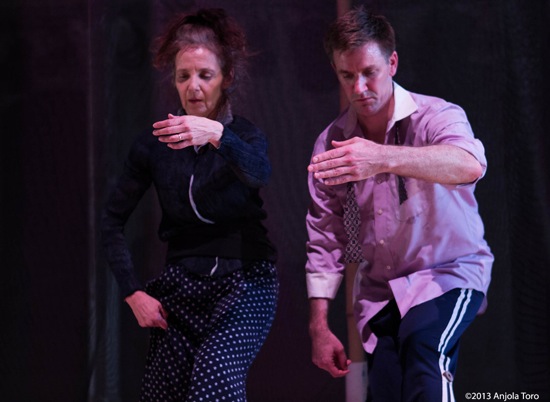
Vicky Shick and Jon Kinzel in Shick’s Everything You See (not the final costumes). Photo: Anjola Toro
In fact, all the dancers are marvelously interesting. Most remarkable is the fact that, although they perform expertly, they look as if they’re making everything up on the spot and deciding when to do what. Maybe they give that impression because each of them knows—and has to keep track of— so many little modules of movement.
One of Shick’s gifts as a choreographer is her ability to make non sequiturs flow together or seem inevitable. Several clumped dancers jump stiffly up and down, the way kids do while saying, “Goody!” over and over. Then they recline on their sides, heads propped on one hand, and contemplate the space. Small actions like fluttering hands or wobbling knees may follow large-scale ones, such as a sudden leap or the arc of a person’s arm as she reaches for her own swung-up leg. She’s also a master at mixing looseness with precision, an easy, voluptuous fluidity with small sharp moves.
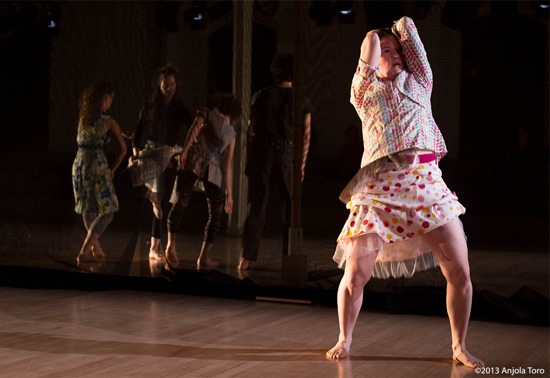
Jodi Bender. At back (L to R): Marilyn Maywald, Donna Costello, Lily Gold, Olsi Gjeci. Photo:Anjola Torto
At first Everything You See seems to be more than you can see, because so many eye-grabbing things are happening. You learn to zero in to watch, say, Perron and Shick sitting close together on the floor and squirming around to contact each other with an elbow or a cheek. Or Costello, leaning back against Olsi Gjeci and kind of sliding partway down his body, while he stares past her, windmilling his arms. Or Jodi Bender knocking herself out, dancing as if she’s trying to shuck herself out of her clothes while evading an intruder. Or Lily Gold jittering around on tiptoe, brushing away what might be insects bent on nesting in her dark, fuzzy hair. Or a whole gang of people running in a cluster around the screens; they look back, swerve, and change positions as they go, the way people do when they’re urging one another on, or checking to see that the group is staying together.
Eventually, it becomes clear that movement passages and configurations that first appeared on one side of the fence will likely appear on the other. There’s Laurel Tentindo and Gjeci grasping hands and pulling away from each other as fully as they can without letting go. Remember that? Toward the end of Everything You See, the pace of the repetitions increases. Watching them fly by is almost intoxicating. A veritable high-school reunion of familiar faces.
Those of us on the east side of the nave may wonder whether a small wooden table is ever going to make it to our area, and at the very end of the dance, it does. Here’s Maywald standing on it just the way she did for our neighbors across the way. And Kinzel is sitting pensively on the edge of it again. As the music dies, she pulls her nose, checks one leg, touches her hair, brushes something off her skirt. The lights go out.
Everything we saw we no longer see. Except in the mind’s eye, where it’ll glimmer for some time.

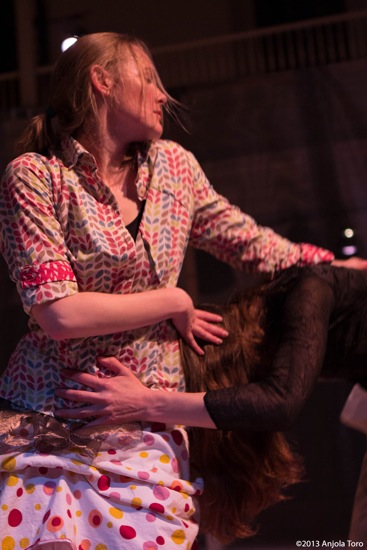
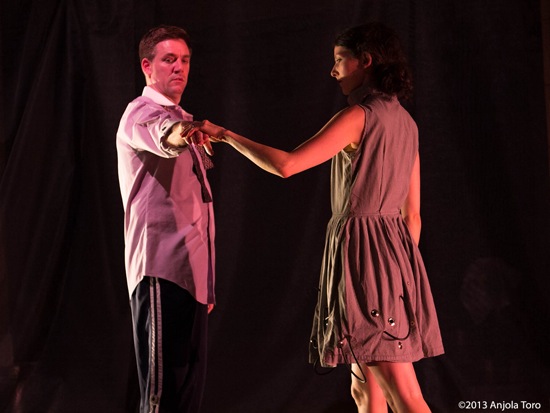
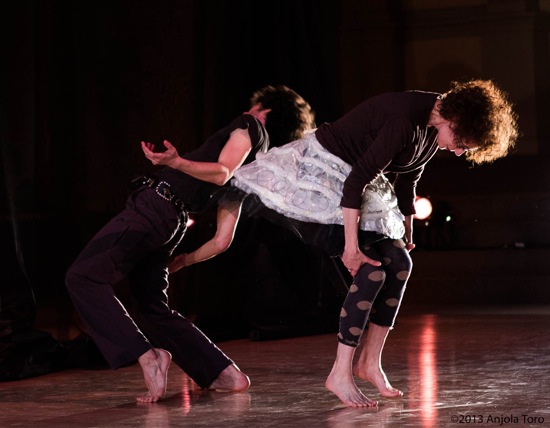
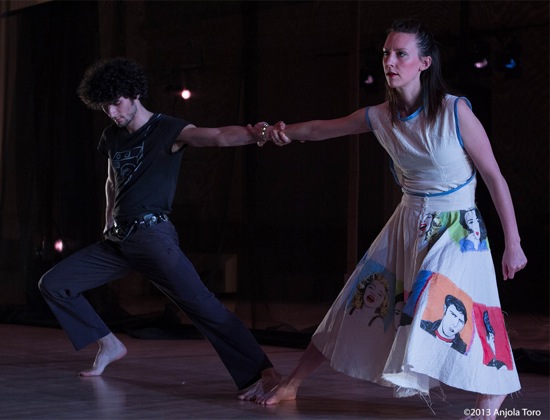
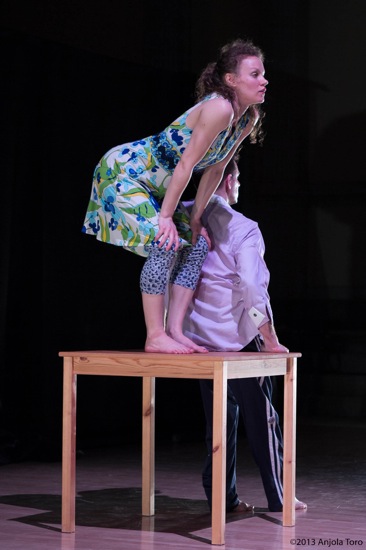
I didn’t get to see Vicky’s dance, but the concept sounds very much like my first collaboration with architect Scott De Vere in 1988, called “Site Line,” in which we divided St. Mark’s along its center line and arrayed the audience on both sides. The dividing “wall” was 3′ deep, and the dancers passed from side to side but doing different material. I wanted each half of the audience to have a different experience (with glimpses of what was on the other side), not the same experience at different times.